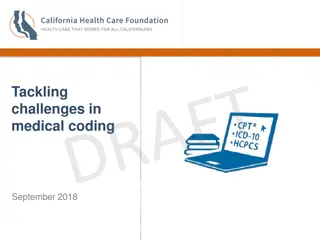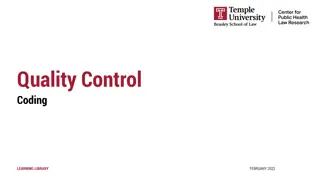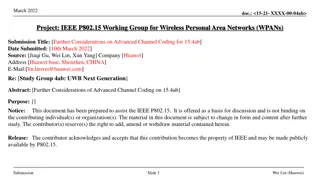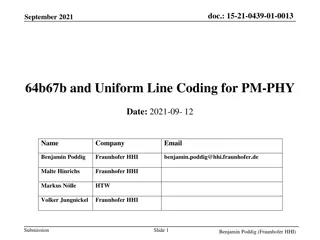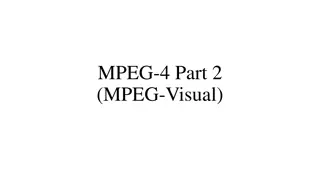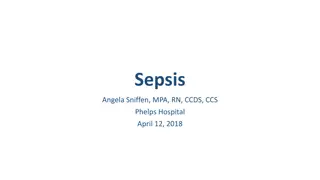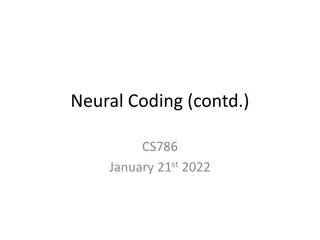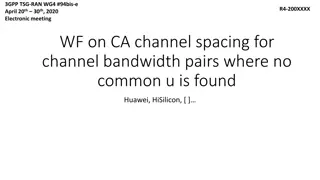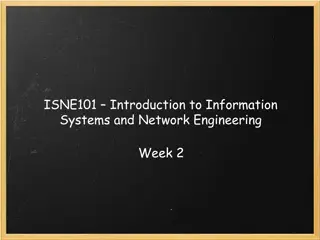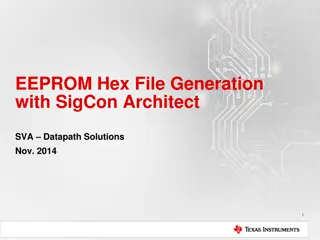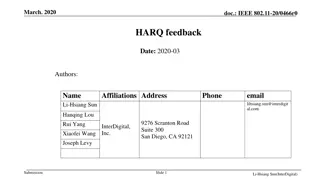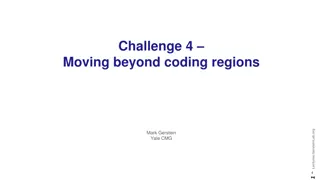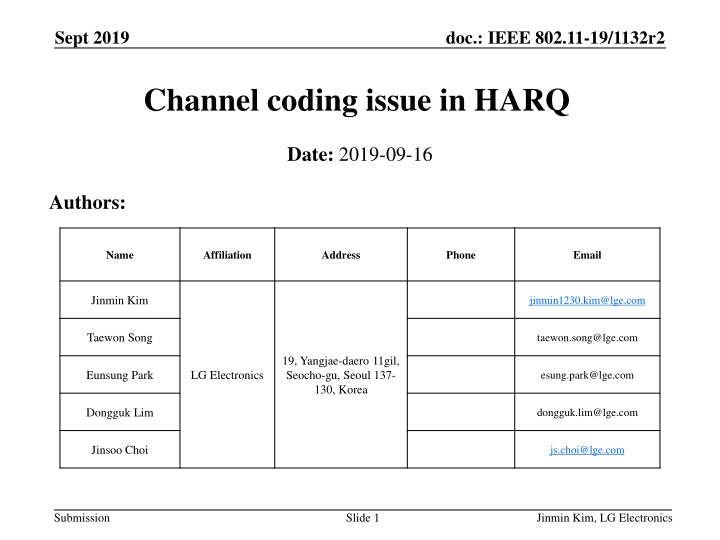
Channel Coding Issue in HARQ - Benefits and Throughput Gain Analysis
Explore the IEEE 802.11-19/1132r2 document discussing channel coding issues in HARQ, highlighting benefits, throughput gains, and various related issues such as HARQ methods, collision problems, hardware complexity, and more. Simulation results show how HARQ can enhance Wi-Fi systems by utilizing LDPC IR methods effectively.
Download Presentation

Please find below an Image/Link to download the presentation.
The content on the website is provided AS IS for your information and personal use only. It may not be sold, licensed, or shared on other websites without obtaining consent from the author. If you encounter any issues during the download, it is possible that the publisher has removed the file from their server.
You are allowed to download the files provided on this website for personal or commercial use, subject to the condition that they are used lawfully. All files are the property of their respective owners.
The content on the website is provided AS IS for your information and personal use only. It may not be sold, licensed, or shared on other websites without obtaining consent from the author.
E N D
Presentation Transcript
Sept 2019 doc.: IEEE 802.11-19/1132r2 Channel coding issue in HARQ Date: 2019-09-16 Authors: Name Affiliation Address Phone Email Jinmin Kim jinmin1230.kim@lge.com Taewon Song taewon.song@lge.com 19, Yangjae-daero 11gil, Seocho-gu, Seoul 137- 130, Korea Eunsung Park LG Electronics esung.park@lge.com Dongguk Lim dongguk.lim@lge.com Jinsoo Choi js.choi@lge.com Submission Slide 1 Jinmin Kim, LG Electronics
Sept 2019 doc.: IEEE 802.11-19/1132r2 Recap on [1-17] So far, even if the amount of gain is different, [1-17] show the benefits and throughput gain of HARQ And, various issues (e.g. HARQ method(CC/IR/punctured CC), HARQ unit, collision issue, HW complexity, HARQ-SIG/feedback design, etc.) are discussed Based on our simulation results in this contribution, we want to make it more clear that HARQ will bring benefits to Wi-Fi system Submission Slide 2 Jinmin Kim, LG Electronics
Sept 2019 doc.: IEEE 802.11-19/1132r2 LDPC IR method in HARQ First of all, to evaluate the performance of HARQ, we consider LDPC IR method below to transmit additional parity bits (This is just example, other methods are possible) 1st step: Encoding with one level lower coderate than designated code rate (code rate set : [1/2, 2/3, 3/4, 5/6]) 2nd step: Puncturing parity bits to make same code rate as designated code rate 3rd step: For retransmission, different puncturing pattern is used This example assumes self-decodable packet in any (re)transmissions. So, it doesn t require the increase in LDPC CW processing rate. HARQ (Designated R=2/3) ARQ (Designated R=2/3) Actual encoding R=1/2 Information bits Parity bits R=2/3 Information bits Parity bits Discard punctured bits Discard punctured bits Information bits Parity bits Information bits Parity bits Transmission Transmitted R=2/3 Transmitted R=2/3 Re-transmission Initial transmission Submission Slide 3 Jinmin Kim, LG Electronics If combining, effective R=1/2
Sept 2019 doc.: IEEE 802.11-19/1132r2 Simulation Assumptions Simulation assumptions 802.11ax, 80 MHz, Regular GI, 4x HE-LTF, TGnD channel MIMO(2x2), LDPC, MCS 0~7 Optimal MCS selection Sub-optimal MCS selection Select highest MCS with <10% PER based on long-term measurement Packet length=1000bytes, single MPDU per PPDU Up to 2 (re)transmissions Same channel realization is applied across all (re)transmissions If we consider different channel, HARQ can bring a more gain due to time diversity. No impairments, ideal channel estimation, ideal ACK/NACK feedback Submission Slide 4
Sept 2019 doc.: IEEE 802.11-19/1132r2 Simulation Results: PER performance Data FER Curve Data FER Curve 0 0 10 10 MCS0 MCS1 MCS2 MCS3 MCS4 MCS5 MCS6 MCS7 MCS0 MCS1 MCS2 MCS3 MCS4 MCS5 MCS6 MCS7 -1 -1 10 10 - ARQ - HARQ (CC) - HARQ (IR) -2 FER -2 FER 10 10 -3 -3 10 10 -4 -4 10 10 -5 0 5 10 15 20 25 30 -5 0 5 10 15 20 25 30 SNR (dB) SNR (dB) Observation points: IR scheme shows better performance than CC and ARQ. Especially for non- code rate, additional parity bits increase the gain effectively. (e.g. MCS=2, 4, 5, 6 and 7) And, the PER curve per MCS in IR is evenly distributed than others. It means that link adaptation can be managed efficiently. Submission Slide 5 Jinmin Kim, LG Electronics
Sept 2019 doc.: IEEE 802.11-19/1132r2 Simulation Results: Goodput performance 8 8 ARQ vs HARQ Goodput ARQ vs HARQ Goodput 6x 10 6x 10 ARQ HARQ(CC) HARQ(IR) ARQ HARQ(CC) HARQ(IR) 5 5 Optimal MCS selection Sub-optimal MCS selection 4 4 Goodput(bps) Goodput(bps) 3 3 2 2 1 1 0 0 -5 0 5 10 15 20 25 30 -5 0 5 10 15 20 25 30 SNR (dB) SNR (dB) Observation points: In low SNR region, HARQ shows better performance than ARQ The IR shows better performance even in high SNR region The IR scheme enables sophisticated link adaptation without additional MCS definition due to smoother curve It is caused by evenly distributed PER curve Slide 6 Submission Jinmin Kim, LG Electronics
Sept 2019 doc.: IEEE 802.11-19/1132r2 Introduction of HARQ into Wi-Fi Although we assume self-decodable packet, only up to 2 (re)transmission and initial version of LDPC IR method, HARQ shows better performance than ARQ It is clear that if we consider partial IR, further enhanced IR scheme and optimal retransmission number(e.g. up to 3 or 4), the gain from HARQ can be increasing. So, we think TGbe shall support HARQ for data frame Also, since the IR scheme shows better performance than other methods, we should consider IR scheme in HARQ Submission Slide 7 Jinmin Kim, LG Electronics
Sept 2019 doc.: IEEE 802.11-19/1132r2 Channel coding issue From 802.11a, Wi-Fi system has kept the BCC because it has a merit in short packet case and has low HW complexity In general, parity check matrix in LDPC is designed to have a best performance when there are no punctured bits However, in short packet case, many parity bits are punctured in order not to increase PPDU length compared to BCC case. This may cause performance degradation Furthermore, high PHY preamble ratio in short packet case increases the retransmission overhead So, we d like to investigate HARQ performance in short packet case Submission Slide 8
Sept 2019 doc.: IEEE 802.11-19/1132r2 The number of punctured bits In spec., the number of punctured bits is computed by following equation ?????= ???(?, ??? ????? ??????? ?????) The BW, number of information bits, MCS and Nss are the factors to calculate the number of punctured bits When we assume reasonable packet length(>100bytes, e.g. VoIP, Appendix 1), The table below shows the maximum puncturing case per MCS MCS(20MHz, Nss=1) 0 1 2 3 4 5 6 7 Information size(bytes) 247B 247B 238B 162B 248B 329B 373B 417B The number of punctured bits per CW 296bits 278bits 138bits 268bits 126bits 173bits 128bits 84bits Ratio % (Punctured bits/parity bits) 30.5% 28.6% 28.4% 27.6% 25.9% 26.7% 26.3% 25.9% Submission Slide 9 Jinmin Kim, LG Electronics
Sept 2019 doc.: IEEE 802.11-19/1132r2 Performance in short packet (ARQ) 6 ARQ Goodput 14x 10 BCC LDPC 12 Simulation parameter 802.11ax, 20 MHz, TGnD channel SISO, BCC/LDPC, MCS 0~7 Optimal MCS selection Packet length (see previous page) 10 Goodput(bps) 8 6 4 2 0 -5 0 5 10 15 20 25 30 SNR (dB) Data FER Curve 0 10 MCS0 MCS1 MCS2 MCS3 MCS4 MCS5 MCS6 MCS7 BCC LDPC LDPC shows 1~3dB better performance than BCC even in maximum puncturing case -1 FER 10 -2 Submission Slide 10 Jinmin Kim, LG Electronics 15 20 SNR (dB) 10 0 5 10 25 30
Sept 2019 doc.: IEEE 802.11-19/1132r2 Performance in short packet (HARQ) 6 ARQ & HARQ Goodput 14x 10 BCC-ARQ LDPC-ARQ BCC-HARQ LDPC-HARQ Simulation parameter BCC IR[11, 13] / LDPC IR Packet length (see the appendix) Optimal MCS selection Up to 2 (re)transmissions PHY&MAC overhead are considered PHY Preamble, IFS, backoff, ACK duration 12 10 Goodput(bps) 8 6 4 2 0 -5 0 5 10 15 20 25 30 Data FER Curve SNR (dB) 0 10 MCS0 MCS1 MCS2 MCS3 MCS4 MCS5 MCS6 MCS7 BCC LDPC Even considering PHY&MAC overhead, HARQ shows better performance and smoother curve than ARQ The gap can be increased if we consider realistic link adaptation -1 FER 10 -2 10 0 5 10 15 20 25 30 Submission Slide 11 Jinmin Kim, LG Electronics SNR (dB)
Sept 2019 doc.: IEEE 802.11-19/1132r2 Conclusions We show HARQ performance and verify that HARQ brings benefits to Wi-Fi system even in sub-optimal scenario The more sophisticated HARQ scheme can increase the gain. Even in short packet case, HARQ shows better performance and smoother curve than ARQ considering PHY&MAC overhead In our results, LDPC always shows better performance than BCC even in maximum puncturing case Considering current chip manufacturing skill, HW complexity is no longer a problem So, we may need to reconsider whether we keep BCC in 11be if we adapt HARQ in 11be Submission Slide 12 Jinmin Kim, LG Electronics
Sept 2019 doc.: IEEE 802.11-19/1132r2 Straw poll/motion #1 Do you agree to add the following text into SFD? TGbe shall support HARQ for unicast data and management frame transmission Other frames(control, multicast and broadcast) are TBD Submission Slide 13 Jinmin Kim, LG Electronics
Sept 2019 doc.: IEEE 802.11-19/1132r2 Straw poll/motion #2 Do you agree to add the following text into SFD? TGbe shall support LDPC as the mandatory coding scheme for HARQ transmission in all bandwidth cases and all spatial stream cases. Submission Slide 14 Jinmin Kim, LG Electronics
Sept 2019 doc.: IEEE 802.11-19/1132r2 Straw poll/motion #3 Do you agree to add the following text into SFD? TGbe shall support IR(incremental redundancy) scheme which includes to transmit additional parity bits for HARQ retransmission. Submission Slide 15 Jinmin Kim, LG Electronics
Sept 2019 doc.: IEEE 802.11-19/1132r2 References [1] 18/1116r0, Distributed MU-MIMO and HARQ Support for EHT [2] 18/1547r0, Technology Features for 802.11 EHT [3] 18/1549r0, Recommended Direction for EHT [4] 18/1587r1, HARQ for EHT [5] 18/1955r0, HARQ for EHT Further Information [6] 18/1963r1, Discussion on HARQ for EHT [7] 18/1979r1, HARQ performance analysis [8] 18/1992r1, HARQ Feasibility for EHT [9] 18/2029r1, HARQ in EHT [10] 18/2031r0, HARQ Gain Studies [11] 19/0070r0, HARQ in Collision-Free and Collision-Dominated Environments [12] 19/0390r0, Effect of Preamble Decoding on HARQ in 802.11be [13] 19/0780r0 Consideration on HARQ [14] 19/0792r0, Comparisons of HARQ transmission schemes for 11be [15] 19/0798r0, HARQ Simulation Results [16] 19/0873r0, HARQ Framing [17] 19/1038r0, HARQ with A-MPDU in 11be Submission Slide 16
Sept 2019 doc.: IEEE 802.11-19/1132r2 Appendix 1 Example of VoIP packet size In IEEE 802.16m Evaluation Methodology Document(IEEE 802.16m-08/004r5) Instead of 802.16e Header and CRC, we assume 802.11 Header and CRC (34bytes) and AMR without Header compression IPv4 active(73 bytes) In this case, total VoIP packet size is 107byts Submission Slide 17 Jinmin Kim, LG Electronics
Sept 2019 doc.: IEEE 802.11-19/1132r2 Appendix 2 The maximum puncturing case in HARQ Since we encode with one level lower code rate except MCS 0, 1 and 3, the number of punctured bits is different from ARQ MCS(20MHz, Nss=1) 0 1 2 3 4 5 6 7 Information size(bytes) 247B 247B 331B 162B 331B 256B 351B 390B The number of punctured bits per CW 296bits 278bits 352bits 268bits 352bits 614bits 336bits 278bits Ratio % (Punctured bits/parity bits) 30.5% 28.6% 54.3% 27.6% 54.3% 63.2% 51.9% 57.2% MCS 0, 1 and 3 have code rate which is lowest one. Submission Slide 18 Jinmin Kim, LG Electronics




